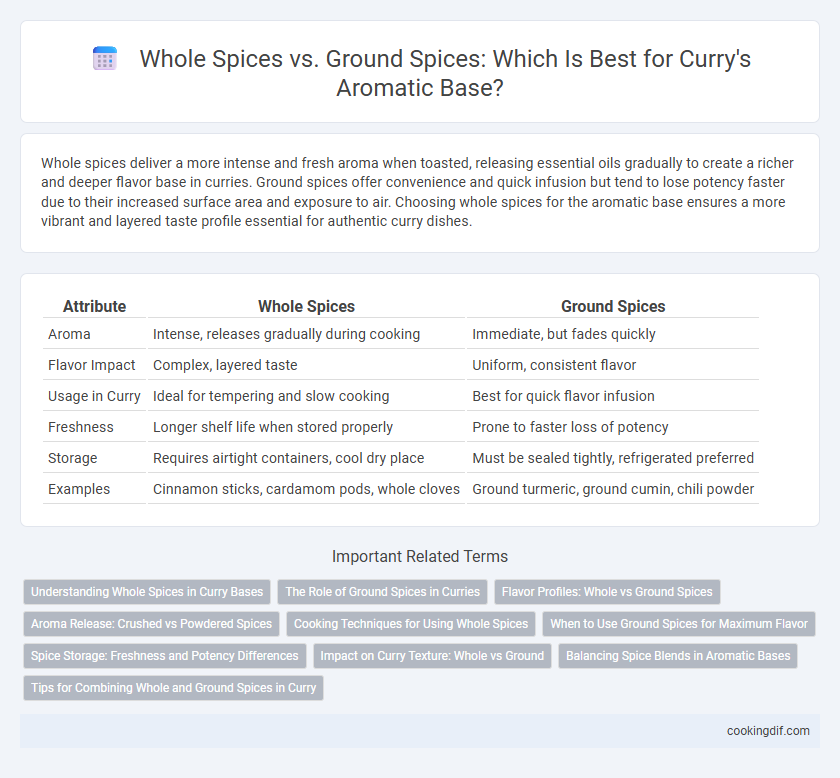Whole spices deliver a more intense and fresh aroma when toasted, releasing essential oils gradually to create a richer and deeper flavor base in curries. Ground spices offer convenience and quick infusion but tend to lose potency faster due to their increased surface area and exposure to air. Choosing whole spices for the aromatic base ensures a more vibrant and layered taste profile essential for authentic curry dishes.
Table of Comparison
| Attribute | Whole Spices | Ground Spices |
|---|---|---|
| Aroma | Intense, releases gradually during cooking | Immediate, but fades quickly |
| Flavor Impact | Complex, layered taste | Uniform, consistent flavor |
| Usage in Curry | Ideal for tempering and slow cooking | Best for quick flavor infusion |
| Freshness | Longer shelf life when stored properly | Prone to faster loss of potency |
| Storage | Requires airtight containers, cool dry place | Must be sealed tightly, refrigerated preferred |
| Examples | Cinnamon sticks, cardamom pods, whole cloves | Ground turmeric, ground cumin, chili powder |
Understanding Whole Spices in Curry Bases
Whole spices in curry bases release essential oils slowly, creating a richer and more complex aroma compared to ground spices. Toasting whole spices like cinnamon sticks, cumin seeds, and cardamom pods intensifies their flavor, providing a robust foundation that enhances the curry's depth. Using whole spices allows for gradual infusion during cooking, resulting in a more balanced and fragrant curry.
The Role of Ground Spices in Curries
Ground spices play a crucial role in curries by releasing their essential oils more quickly than whole spices, creating a rich and evenly distributed aromatic base. They blend seamlessly into sauces, enhancing depth of flavor and ensuring consistent heat and spice throughout the dish. Common ground spices like turmeric, cumin, and coriander provide intensity and complexity that define the character of traditional curry recipes.
Flavor Profiles: Whole vs Ground Spices
Whole spices release intense, layered flavors when toasted or simmered, creating a rich aromatic base crucial for authentic curry dishes. Ground spices offer immediate and uniform flavor infusion, ideal for quick cooking but may lose potency faster than whole counterparts. Choosing between whole and ground spices affects the depth and complexity of flavor profiles, with whole spices enhancing warmth and earthiness while ground spices provide boldness and convenience.
Aroma Release: Crushed vs Powdered Spices
Whole spices release aroma gradually when crushed, providing a more intense and complex fragrance throughout cooking, while ground spices emit aroma quickly but fade faster due to increased surface area exposure. Crushing whole spices just before use preserves essential oils, resulting in a fresher and more potent aromatic base in curries. Powdered spices, although convenient, often lose volatile compounds over time, diminishing their aromatic impact compared to freshly crushed whole spices.
Cooking Techniques for Using Whole Spices
Whole spices like cumin seeds, cardamom pods, and cloves release deeper, more complex flavors when tempered in hot oil at the start of cooking, creating a rich aromatic base for curries. Toasting whole spices intact preserves their essential oils, enhancing the dish's fragrance and depth compared to pre-ground powders that lose potency quickly. Mastery of tempering techniques, including the right oil temperature and brief tossing to avoid burning, ensures optimal flavor extraction from whole spices.
When to Use Ground Spices for Maximum Flavor
Ground spices release their flavors quickly, making them ideal for dishes requiring a strong aromatic base in a short cooking time, such as curries finished with a rapid simmer. They integrate seamlessly into sauces, enhancing the depth and complexity of flavor without the need for prolonged cooking. Use ground spices when you want an immediate and intense infusion of essential oils extracted during the initial stages of cooking.
Spice Storage: Freshness and Potency Differences
Whole spices retain essential oils longer than ground spices, preserving their aroma and potency during storage. Grinding increases surface area, causing faster oxidation and loss of flavor, which reduces the spice's effectiveness over time. Proper storage in airtight containers away from heat and light is critical to maintaining the freshness and vibrant taste of both forms.
Impact on Curry Texture: Whole vs Ground
Whole spices in curry create a layered texture by releasing bursts of aroma and flavor gradually during cooking, resulting in a more complex mouthfeel. Ground spices blend uniformly into the curry, producing a smoother, more consistent texture but may lose some distinct aromatic nuances. Choosing whole or ground spices significantly influences the curry's final sensory experience, balancing texture and flavor intensity.
Balancing Spice Blends in Aromatic Bases
Whole spices retain essential oils and aromatic compounds longer, providing a richer and more complex flavor profile when toasted or simmered in curry bases. Ground spices offer convenience and immediate intensity but can lose potency quickly, potentially leading to a less balanced aroma if overused. Balancing spice blends involves combining whole spices like cumin, coriander, and cardamom with ground spices to achieve depth and a harmonious, multi-layered aromatic base in curry dishes.
Tips for Combining Whole and Ground Spices in Curry
Combining whole and ground spices in curry enhances the aromatic base by layering complex flavors, as whole spices release essential oils slowly when toasted or fried, while ground spices provide immediate, intense color and taste. Toast whole spices like cinnamon sticks, cardamom pods, and cumin seeds in hot oil to unlock deep fragrance before adding ground spices such as turmeric, coriander, and chili powder for a balanced and rich curry profile. For optimal flavor extraction, adjust cooking time by adding ground spices later in the process to prevent bitterness and preserve their vibrant aroma.
Whole spices vs Ground spices for aromatic base Infographic

 cookingdif.com
cookingdif.com